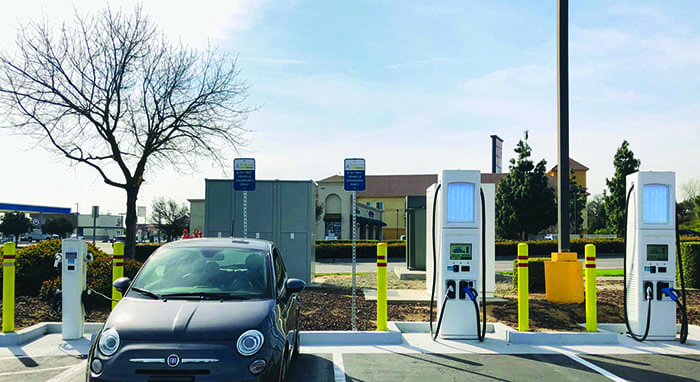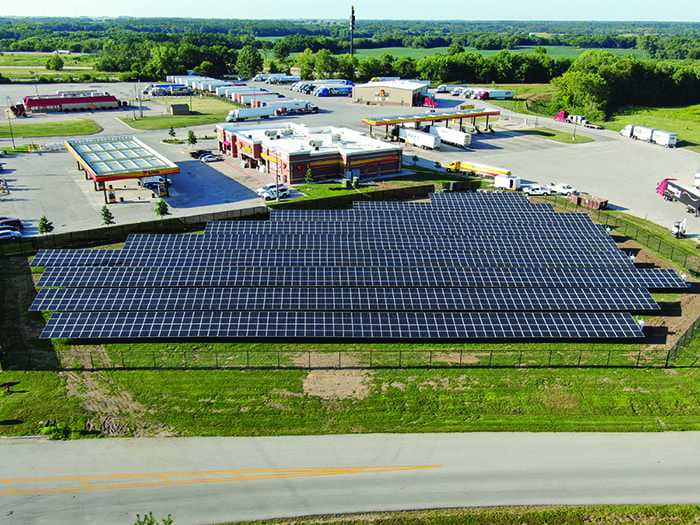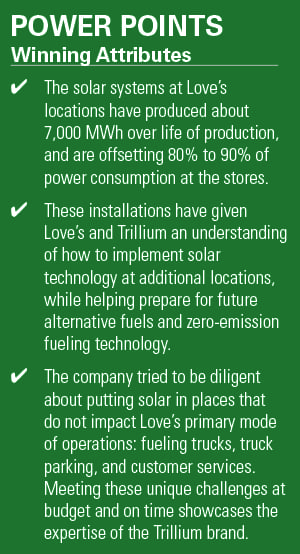Traveling the Electrification Highway
The post Traveling the Electrification Highway appeared first on POWER Magazine.

 |
A company that has served U.S. motorists and the trucking industry for decades has updated its business model to support electric vehicle charging-and generate electricity for several of its locations.
Power industry analysts say electrification of the U.S. transportation sector is poised for dramatic growth. Automakers are committed to building electric vehicles (EVs), more companies are electrifying their fleets, and the Biden administration has asked lawmakers to support $174 billion worth of vehicle electrification and charging initiatives, along with expanding EV purchase incentives for consumers.
There are obstacles to that growth. Among the major challenges is the buildout of charging infrastructure, to make recharging an EV as convenient as filling a gas tank.
Love's Travel Stops, an Oklahoma City, Oklahoma-based company well known to travelers across much of the U.S., has built a network of locations dedicated to providing the trucking industry and motorists with a place to refuel. Love's family of companies includes Trillium, its unit that provides alternative fuels, including compressed natural gas (CNG) and hydrogen. Trillium also provides solar power installation, EV charging infrastructure, and on-site electricity generation.
Among Trillium's achievements is the company's support of California's Central Valley Electric Highway, part of a larger EV charging highway project. The California charging installations, completed last year, are the result of a partnership between Trillium and EV Connect, a cloud-based software platform for managing EV charging stations.
The company's innovation has continued with deployment of EV chargers at Love's locations that generate their own power from solar installations at the sites. Trillium recently completed solar energy installations at three Love's store locations in Illinois, joining others in California and Love's first solar project in New Mexico. The solar systems are interconnected with each location and will offset the electricity demand from the stores; any excess power generated will then be exported to the respective city's power grid through a net-metering program.
Love's originally began looking at solar to decrease operating expenses and operate in a more environmentally friendly way," said Kim Okafor, the company's strategic business development manager. Hundreds of different Love's locations were considered. Store canopies and other spaces were looked at to determine the most optimal location for solar installations. These installations have given us an understanding of how to implement solar technology at additional locations in the future. We know that electrification is coming, and these installations help us prepare for future alternative fuels and zero-emission fueling technology."
The Love's and Trillium power projects are an example of how long-standing companies-in this case, a group approaching its 60th year in operation-are adapting to the changing energy landscape and transforming their commercial business to accommodate future growth. The company's model makes it a worthy recipient of POWER's 2021 Commercial and Industrial Generation Award.
 |
1. This electric vehicle charging unit is located at the Love's store in Ripon, California. It is part of Love's and Trillium's support for the West Coast Electric Highway. The California project was completed last year with installations of charging stations at three Love's locations. Courtesy: Love's Travel Stops |
Trillium designed and built the solar energy systems used to convert three travel stops in Illinois to solar power, a project whose completion was announced in late May. Trillium is excited to continue working with Love's in expanding its use of on-site, solar power generation," said JP Fjeld-Hansen, vice president of Trillium, in a news release announcing the milestone. Trillium is proud to produce green energy for these locations, as well as for the residents of Hamel, Kankakee and Knoxville."
In addition to the three Illinois locations, the Love's Travel Stops now using solar power systems include five designed by Trillium in California-in Santa Nella, Madera, Corning, Barstow, and Boron-along with Love's first solar installation, a project in Las Vegas, New Mexico, that began operating in 2016.
Love's renewable and alternative fuels company, Trillium, designed and built most of the solar arrays in the Love's network," Okafor told POWER. We worked with Cynergy, GRNE, and Paradise Energy Solutions to design, engineer, and construct the arrays. Trillium leveraged its experience of sophisticated on-site monitoring of CNG and hydrogen stations to develop a monitoring system for the arrays in the network."
Said Okafor: The solar array systems that we've installed to date include solar modules, inverters, racking systems, and electrical distribution gear. One of our solar array systems includes an on-site energy storage system (i.e., a battery). The equipment providers have been Canadian Solar for the modules and inverters, RBI for the racking, Hyundai for solar modules, Selectria for inverters, and Stem for the on-site battery systems. Trillium's Automation & Programming Team developed a monitoring system for our solar array network." The system designs included research into construction costs, and the company's savings from producing its own power.
Each project's investment was heavily scrutinized with total cost of ownership considered. The projects met our investment threshold," said Okafor. Our intention was to ensure the systems can withstand the test of time [i.e. 30 years] and provide strong operational and environmental benefits, which is why we did not go with the lowest-cost system. Over the life of production, we have produced about 7,000 MWh and are offsetting 80-90% of power consumption at the stores. The entire overall project started with trying to offset energy used at the travel stops and turned into a story of preparation for the zero-emission future."
Construction ChallengesInstalling a solar array at a site already in operation presented some challenges, but Love's and Trillium had experience when it came to addressing those issues.
The challenges faced in building a solar array aren't very different than those experienced in building alternative fueling stations. Like the deployment of alternative fueling stations, we ran into permitting and utility challenges at some locations," said Okafor. The Love's stores where we deployed the solar arrays were not originally built with solar in mind, so we ran into some technical challenges. Many of the stores had been running for decades and needed to be retrofitted for solar. During installation some stores had to be taken off utility power to interconnect the solar system. Taking a busy Love's store that serves customers 24 hours a day, seven days a week is very challenging."
Okafor continued: Finding space for the solar arrays was another challenge we encountered. We tried to be diligent about putting solar in places that do not impact Love's primary mode of operations: fueling trucks, truck parking, and customer services. Meeting these unique challenges at budget and on time showcases the expertise of the Trillium brand."
The California project completed last year enabled new charging stations to expand that state's portion of the almost 4,000-mile West Coast Electric Highway, aimed at providing charging stations every 25 to 50 miles along the highway. The three Love's charging sites feature rates of 50 kW or 150 kW, and accommodate charging for up to four vehicles at one time. The new charging stations, including direct-current fast chargers (DCFCs) and level-2 chargers at Love's stations in Ripon, Madera, and Tulare, use EV Connect's EV Cloud, an innovative cloud-based software platform for managing EV charging infrastructure.
The installations were partly funded by the California Energy Commission's Alternative and Renewable Fuel and Vehicle Technology Program, along with the San Joaquin Valley Air Pollution Control District's Charge Up Program, and highlight technology advancements for EV charging stations. EV Connect, a partner in the deployments, provides what it calls the industry's largest open-standards EV charging cloud platform for managing networks of charging stations, along with those stations' interaction with utilities. It also touts an improved experience for drivers, as EV Connect's Electric Vehicle Charge Station (EVCS) Certification Program offers options to select from several charging stations. Drivers also can gain real-time access to the status of Love's charging stations through the EV Connect driver app.
Love's Travel Stops are a mainstay of the American road trip, and we are excited to help roll out charging locations on the nation's highway system and bring long-distance mobility to electric vehicles," said Jordan Ramer, founder, and CEO of EV Connect. We are pleased to work with Trillium to deploy their DCFCs in strategic locations to fulfill part of EV Connect's deployment program under the California Energy Commission grant program."
 |
Love's and Electrify America, which operates a fast-charging EV network in the U.S., last year announced a rollout of seven charging stations with a combined 28 EV chargers at seven Love's locations in six states.
As we continue building charging stations at accessible sites, Love's Travel Stops was a perfect fit because of its convenient locations near major highways," said Rachel Moses, senior manager for site acquisition, development, and strategy at Electrify America. Providing EV drivers with the opportunity to charge their vehicles at Love's locations will help instill confidence for longer interstate trips, and can encourage more consumers to consider making the switch to electric."
Anthony Lambkin, director of operations for Electrify America, told POWER that Love's Travel Stops was an obvious partner for the project. We consider if the site host has nearby amenities and activities so drivers can conveniently complete daily tasks like grocery shopping or dining and enjoy entertainment while their vehicle charges," Lambkin said. Love's Travel Stops fit many of these criteria-their sites are often located off major highways, and they offer shopping and dining options for drivers. Through projects like our collaboration with Love's, Electrify America is building a network of electric vehicle charging stations across the country... this, in turn, helps encourage EV adoption and brings us closer to a more sustainable future."
Okafor told POWER that Love's corporate culture includes sustainable business practices, always with an eye toward the needs of customers.
Love's culture is customer and entrepreneurial centered," Okafor said. As demand for decarbonization grows, we will continue to grow this part of our business. We always keep an eye on the future to ensure we are ready to provide whatever our customers need."
-Darrell Proctor is a senior associate editor for POWER (@POWERmagazine).
The post Traveling the Electrification Highway appeared first on POWER Magazine.